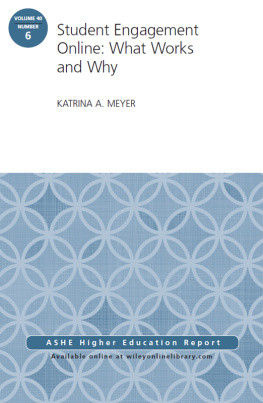Cover design by Michael Cook
Cover image: RomanOkopny
Copyright 2014 by John Wiley & Sons, Inc. All rights reserved.
Published by Jossey-Bass
A Wiley Brand
One Montgomery Street, Suite 1200, San Francisco, CA 94104-4594 www.josseybass.com
No part of this publication may be reproduced, stored in a retrieval system, or transmitted in any form or by any means, electronic, mechanical, photocopying, recording, scanning, or otherwise, except as permitted under Section 107 or 108 of the 1976 United States Copyright Act, without either the prior written permission of the publisher, or authorization through payment of the appropriate per-copy fee to the Copyright Clearance Center, Inc., 222 Rosewood Drive, Danvers, MA 01923, 978-750-8400, fax 978-646-8600, or on the Web at www.copyright.com . Requests to the publisher for permission should be addressed to the Permissions Department, John Wiley & Sons, Inc., 111 River Street, Hoboken, NJ 07030, 201-748-6011, fax 201-748-6008, or online at www.wiley.com/go/permissions .
Limit of Liability/Disclaimer of Warranty: While the publisher and author have used their best efforts in preparing this book, they make no representations or warranties with respect to the accuracy or completeness of the contents of this book and specifically disclaim any implied warranties of merchantability or fitness for a particular purpose. No warranty may be created or extended by sales representatives or written sales materials. The advice and strategies contained herein may not be suitable for your situation. You should consult with a professional where appropriate. Neither the publisher nor author shall be liable for any loss of profit or any other commercial damages, including but not limited to special, incidental, consequential, or other damages. Readers should be aware that Internet Web sites offered as citations and/or sources for further information may have changed or disappeared between the time this was written and when it is read.
Jossey-Bass books and products are available through most bookstores. To contact Jossey-Bass directly call our Customer Care Department within the U.S. at 800-956-7739, outside the U.S. at 317-572-3986, or fax 317-572-4002.
Wiley publishes in a variety of print and electronic formats and by print-on-demand. Some material included with standard print versions of this book may not be included in e-books or in print-on-demand. If this book refers to media such as a CD or DVD that is not included in the version you purchased, you may download this material at http://booksupport.wiley.com . For more information about Wiley products, visit www.wiley.com .
Library of Congress Cataloging-in-Publication Data
CIP data is available on file at the Library of Congress.
ISBN 978-1-118-53170-9 (pbk)
List of Tables, Exhibits, and Figure
| TABLES |
| Common Reasons for Online Student Dropout |
| Study Participants Demographics |
Factors Distinguishing Face-to-Face and Online
Environments |
Course Design Elements, Strategies, and Ways to
Integrate the Strategies into Course Design |
Ways to Incorporate Motivating Strategies into Course
Design |
| Instructional Support Strategies for Online Courses |
Course Blueprint for the Seminar in the Philosophy and
History of Adult Education |
Managing Tasks and Prioritizing Time for the Seminar
in the Philosophy and History of Adult Education
(Existing Course) |
| EXHIBITS |
| Time Management Strategies |
| Prioritizing Strategies |
| Learning Strategies |
Use of Synchronous Communication to Support Online
Students |
Learning How to Learn Online: Supporting Early and
Persistent Success for New Online Students |
| Self-Care Resources |
| Instructor Checklist for Designing Online Courses |
| FIGURE |
| Persistence Model for Online Student Retention |
Preface
Participation in online education continues to grow in the United States (Allen & Seaman, 2010, 2011). However, concerns for online student retention and factors for student persistence must be taken into consideration. We know that among the reasons for student dropout are feelings of isolation, frustration, and disconnection; technology disruption; lack of contact with faculty; inadequate contact with students on the part of faculty; lack of student and technology support; lack of instructor participation during class discussion; lack of clarity in instructional direction or expectation; and lack of social interaction.
Based on the literature, we also know some factors that have a positive influence on retaining students and reducing dropout rates. Among these factors are previous experience in online courses, student preparation for online education, relevance of the course to students, learning community engagement, desire to complete a degree, and workplace support.












